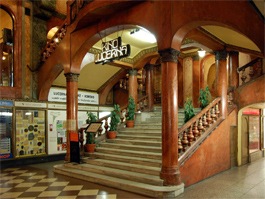
The owners want to register the Lantern as a national cultural monument
 |
The massive complex of walls, glass, and metal called Lucerna, which was built between 1907 and 1921 in the center of the metropolis by the grandfather of former Czech President Václav Havel, is now a cultural monument. The status of a national cultural monument would provide the palace, among other things, with a higher level of protection and increase its chances of obtaining certain grants.
"Practically nothing would change in the operation of Lucerna, it would remain a cultural and social center," said Havlová to ČTK. According to Ivan M. Havel, Lucerna will retain its diverse cultural face, ranging from balls and concerts to the operation of a cinema, restaurants, and cafes.
On Wednesday, a professional conference on the topic of Lucerna Palace - past, present, future will be held at the Lucerna Gallery, featuring a number of experts and architects supporting the nomination of Lucerna for national cultural monument status. Havlová will give a lecture at the conference titled Vision for Future Lucerna. "We expect to learn things at the conference that we do not even know, because many documents were destroyed in the Lucerna fire in the 1970s. The purpose of the conference is to gather new perspectives from experts on Lucerna," Havlová stated.
The unique reinforced concrete structure of the complex, which had only been used for industrial buildings until then, allowed Czech engineer Stanislav Bechyňa to place the largest hall of Lucerna three floors underground. Havel wanted to create a huge underground ice rink based on the model of Berlin. Instead, a social hall was ultimately constructed.
Similarly, today's Lucerna cinema originally served as a theater hall and it even hosted the opera Dalibor. The Art Nouveau palace was the first reinforced concrete building in Prague to feature a roofed and glazed passage, unprecedented in Bohemia at the time. Many significant social events took place in its premises. It also offered housing and housed the Japanese teahouse Yokohama. It also had the first dining automat in Prague, and interested parties could visit a painting and photography studio or a whole range of shops selling artistic items or fashion. More information can be found at www.lucerna.cz.
The English translation is powered by AI tool. Switch to Czech to view the original text source.
0 comments
add comment
Related articles
0
24.06.2024 | Havlová sold a majority stake in the Lucerna Palace for one billion to the BTL group
10
01.10.2018 | Proposal for the declaration of three buildings as immovable cultural monuments
0
12.06.2018 | The Lucerna Palace in Prague will have a new facade
0
20.02.2017 | Invalidovna and Lucerna have become national cultural monuments
0
17.02.2017 | MKČR proposes the Invalidovna or Lucerna as a national cultural monument
0
24.11.2016 | National cultural monuments could include another 18 buildings
0
17.10.2012 | The reconstruction should restore the Lucerna Palace to its former glory
2
20.03.2011 | Václav Havel built in Prague a Secession gem of European format
0
25.11.2009 | Celebration of the 100th anniversary of the Prague cinema Lucerna










